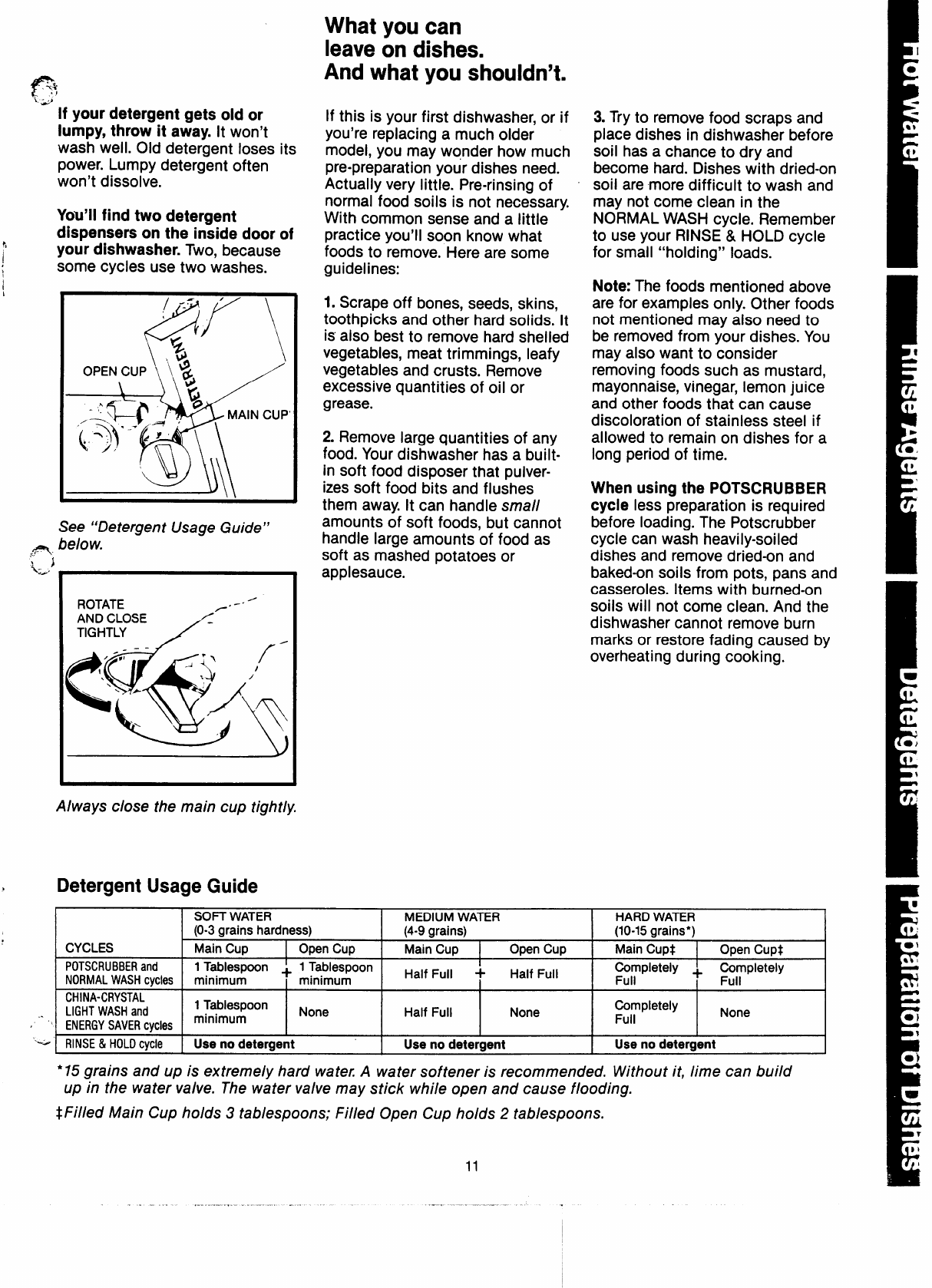
What you can
leave on
dishes.
And what you shouldn’t.
f.
L>;)
If your detergent gets old or
lumpy, throw it away. It
won’t
wash well. Old detergent loses its
power. Lumpy detergent often
won’t dissolve.
You’ll find two detergent
dispensers
on the inside door of
your dishwasher. Two, because
some cycles use two washes.
See “Detergent Usage Guide”
~ below.
,=r
ROTATE
/
/’-
AND CLOSE
TIGHTLY
c!!
-“
/ ,1
1
t
I!&ii
If this is your first dishwasher, or if
you’re replacing a much older
model, you may wonder how much
pre-preparation your dishes need.
Actually very little. Pre-rinsing of
normal food soils is not necessary.
With common sense and a little
practice you’ll soon know what
foods to remove. Here are some
guidelines:
1. Scrape off bones, seeds, skins,
toothpicks and other hard solids. It
is also best to remove hard shelled
vegetables, meat trimmings, leafy
vegetables and crusts. Remove
excessive quantities of oil or
grease.
2. Remove large quantities of any
food. Your dishwasher has a built-
in soft food disposer that pulver-
izes soft food bits and flushes
them away. It can handle
sma//
amounts of soft foods, but cannot
handle large amounts of food as
soft as mashed potatoes or
applesauce.
3. Try to remove food scraps and
place dishes in dishwasher before
soil has a chance to dry and
become hard. Dishes with dried-on
soil are more difficult to wash and
may not come clean in the
NORMAL WASH cycle. Remember
to use your RINSE & HOLD cycle
for small “holding” loads.
Note: The foods mentioned above
are for examples only. Other foods
not mentioned may also need to
be removed from your dishes. You
may also want to consider
removing foods such as mustard,
mayonnaise, vinegar, lemon juice
and other foods that can cause
discoloration of stainless steel if
allowed to remain on dishes for a
long period of time.
When using the POTSCRUBBER
cycle less preparation is required
before loading. The Potscrubber
cycle can wash heavily-soiled
dishes and remove dried-on and
baked-on soils from pots, pans and
casseroles. Items with burned-on
soils will not come clean. And the
dishwasher cannot remove burn
marks or restore fading caused by
overheating during cooking.
Always close the main cup tightly.
b
Detergent Usage Guide
SOFT WATER
I
MEDIUM WATER
HARD WATER
(O-3grains hardness) (4-9grains)
(10-15grains*)
CYCLES
Main Cup
I
Open Cup Main Cup
I
Open Cup
Main Cup~
I
Open Cup*
POTSCRUBBERand
1Tablespoon ~ 1Tablespoon
Half Full +
Completely + Co~pletely
NORMALWASHcycles minimum
minimum
Half Full
Full
CHINA-CRYSTAL
LIGHTWASHand
1Tablespoon
None
Half Full None
Completely
..
minimum
None
“ ENERGYSAVERcycles
Full
‘-~ RINSE&HOLDcycle
Usenodetergent Usenodetergent
Usenodetergent
*15 grains and up is extremely hard watez A water softener is recommended. Without it, lime can build
up in the water valve. The water valve may stick while open and cause flooding.
+Filled Main Cup holds 3 tablespoons; Filled Open Cup holds 2 tablespoons.
11
